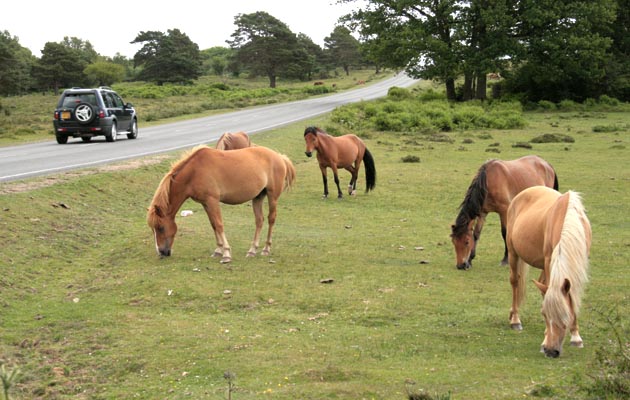Lyndsey Stride on catching wily ponies, keeping up the breed’s quality and the joy of seeing the next generation emerge
At the heart of the New Forest is a core of large commoning families — around 700 commoners who have rights to graze their animals in the forest. Commoners come and go, but nobody starts alone.
My granny was a romantic, a Londoner who cycled all the way here and camped in the New Forest. She didn’t have a clue when she moved here in the 1930s. She was helped by Charlie Penny, who was my husband Robert’s great-grandfather.
{"content":"PHA+VGhlcmUgaXMgbm90aGluZyBsb3ZlbGllciB0aGFuIGdvaW5nIG91dCBpbnRvIHRoZSBmb3Jlc3QgYW5kIHNlZWluZyB5b3VyIHBvbmllcyDigJQgZXNwZWNpYWxseSB3aGVuIHRoZXnigJl2ZSBoYWQgYSBmb2FsLiBJdOKAmXMgbWFnaWNhbC4gUmlkaW5nIGluIHRoZSBmb3Jlc3QgYWxvbmUgYSBob2JieSBoYXdrIHdpbGwgZmx5IGJ5LCBvciB5b3XigJlsbCBoZWFyIGEgbmlnaHRqYXIuIFdoZW4gd2Ugb3BlbiBvdXIgd2luZG93cyBhdCBuaWdodCB0aGV5IGZseSByb3VuZCB0aGUgaG91c2UsIGh1bnRpbmcgZm9yIG1vdGhzLjwvcD4KPHA+PHN0cm9uZz5JdOKAmXMgcmFyZSB0byBzZWUgYSBtYXJlIGZvYWwgaW4gdGhlIGZvcmVzdDwvc3Ryb25nPi4gVGhleSBkaXNhcHBlYXIgZm9yIGEgZGF5IG9yIHR3byBhbmQgY29tZSBiYWNrIHdpdGggdGhlaXIgZm9hbC48L3A+CjxwPjxkaXYgY2xhc3M9ImFkLWNvbnRhaW5lciBhZC1jb250YWluZXItLW1vYmlsZSI+PGRpdiBpZD0icG9zdC1pbmxpbmUtMiIgY2xhc3M9ImlwYy1hZHZlcnQiPjwvZGl2PjwvZGl2PjxzZWN0aW9uIGlkPSJlbWJlZF9jb2RlLTMxIiBjbGFzcz0iaGlkZGVuLW1kIGhpZGRlbi1sZyBzLWNvbnRhaW5lciBzdGlja3ktYW5jaG9yIGhpZGUtd2lkZ2V0LXRpdGxlIHdpZGdldF9lbWJlZF9jb2RlIHByZW1pdW1faW5saW5lXzIiPjxzZWN0aW9uIGNsYXNzPSJzLWNvbnRhaW5lciBsaXN0aW5nLS1zaW5nbGUgbGlzdGluZy0tc2luZ2xlLXNoYXJldGhyb3VnaCBpbWFnZS1hc3BlY3QtbGFuZHNjYXBlIGRlZmF1bHQgc2hhcmV0aHJvdWdoLWFkIHNoYXJldGhyb3VnaC1hZC1oaWRkZW4iPg0KICA8ZGl2IGNsYXNzPSJzLWNvbnRhaW5lcl9faW5uZXIiPg0KICAgIDx1bD4NCiAgICAgIDxsaSBpZD0ibmF0aXZlLWNvbnRlbnQtbW9iaWxlIiBjbGFzcz0ibGlzdGluZy1pdGVtIj4NCiAgICAgIDwvbGk+DQogICAgPC91bD4NCiAgPC9kaXY+DQo8L3NlY3Rpb24+PC9zZWN0aW9uPjwvcD4KPHA+Q29tbW9uZXJzIGhhdmUgYSBuYW1lIGZvciBldmVyeSBncm91cCBvZiB0cmVlcywgZ3JlZW4gYW5kIGJyaWRnZSwgbGlrZSBNYWxsYXJkcyBXb29kLCBNb3VzZSYjODIxNztzIEN1cGJvYXJkIG9yIFN0aW5raW5nIEVkZ2UsIHdoaWNoIGRvZXNu4oCZdCBzbWVsbC4gVGhlcmUgaXMgYSBjbHVtcCBvZiB0cmVlcyB3ZSBjYWxsIFBhcmFkaXNlIExvc3QsIHdoaWNoIHdhcyBuYW1lZCBieSBzb2xkaWVycyBiYXNlZCB0aGVyZSBiZWZvcmUgRC1EYXkuIFdoZW4gSSByaWRlIGFjcm9zcyB0aGUgZm9yZXN0IEkgb2Z0ZW4gdGhpbmsgb2YgdGhvc2Ugd2hvIGhhdmUgYmVlbiBiZWZvcmUgbWUuPC9wPgo8cD48c3Ryb25nPkVhY2ggcG9ueSBoYXMgYSBoYXVudCB3aGVyZSB0aGV5IGxpdmU8L3N0cm9uZz4g4oCUIHdlIHNheSB0aGV5IGFyZSBoYXVudGVkLiBJbiBzdW1tZXJ0aW1lIHRoZXkgZ28gYW5kIHNlZWsgc2hhZGU7IHRoYXTigJlzIHdoZW4gaXTigJlzIGVhc2llc3QgdG8gZmluZCB0aGVtLiBUaGV54oCZbGwgZmluZCBzaGFkZSBpbiB0aGUgc2FtZSBwbGFjZSBmb3IgZ2VuZXJhdGlvbnM7IGEgdHJlZSBzbGlnaHRseSBvdXQgaW4gb3BlbiB3aGVyZSB0aGUgd2luZCB0YWtlcyB0aGUgZmxpZXMgYXdheSwgb3IgYSBkYXJrIHNwaW5uZXkgb3V0IG9mIHNpZ2h0LiBJbiBkYXlzIGdvbmUgYnksIGNvbW1vbmVycyB3b3VsZCBoaWRlIGluIHRoZSBzaGFkZSB0cmVlcyBhbmQgd2FpdCB0aGVyZSB0byBjYXRjaCBhIHBvbnkgZnJvbSB0aGUgYnJhbmNoZXMuPC9wPgo8cD48c3Ryb25nPlRoZSBwb25pZXMgYXJlbuKAmXQgZWFzeSB0byBjYXRjaC48L3N0cm9uZz4gU29tZSBhcmUgZWx1c2l2ZSBhbmQgdGhleeKAmXJlIHRoZSBvbmVzIG15IGh1c2JhbmQgbGlrZXMgYmVzdDsgaGUgY2FsbHMgdGhlbSB3b29kbGFuZCBkd2VsbGVycy4gVGhlIGFydCBvZiBjb2x0IGh1bnRpbmcgaXMgdG8gb3V0d2l0IHRoZSBwb25pZXMsIGxldHRpbmcgdGhlbSB0aGluayB0aGV5IGFyZSBlc2NhcGluZyB3aGVuIHJlYWxseSB0aGV5IGFyZSBoZWFkaW5nIHRvd2FyZHMgYSB3b29kZW4gcG91bmQgd2hlcmUgdGhleSBjYW4gYmUgaGFuZGxlZCBzYWZlbHkuPC9wPgo8ZGl2IGNsYXNzPSJhZC1jb250YWluZXIgYWQtY29udGFpbmVyLS1tb2JpbGUiPjxkaXYgaWQ9InBvc3QtaW5saW5lLTMiIGNsYXNzPSJpcGMtYWR2ZXJ0Ij48L2Rpdj48L2Rpdj4KPHA+VmVyZGVyZXJzIG92ZXJzZWUgdGhlIGZvcmVzdCBhbmQgZW1wbG95IGZpdmUgYWdpc3RlcnMgd2hvIHN1cHBvcnQgdGhlIGNvbW1vbmVycy4gSW4gdGhlIGF1dHVtbiwgcG9uaWVzIGFyZSByb3VuZGVkIHVwIGludG8gd29vZGVuIHBvdW5kcy4gQXQgdGhhdCBwb2ludCBzb21lIGNvbW1vbmVycyB0YWtlIGhvbWUgdGhlaXIgbWFyZXMgYW5kIGZvYWxzIG9yIHBvbmllcyB0byBiZSBzb2xkLiBXaGVuIHlvdSBnbyB0byBCZWF1bGlldSBSb2FkIFBvbnkgU2FsZSB0aGVyZSBhcmUgd29vZGVuIHBvdW5kcyBvbiBiYXJlIGVhcnRoIHdpdGggcG9uaWVzIHN0YW5kaW5nIGhhcHBpbHkg4oCUIHRoZXnigJlyZSBmYW1pbGlhciB3aXRoIHRoYXQgZW52aXJvbm1lbnQgaGF2aW5nIGJlZW4gcm91bmRlZCB1cCBmb3IgZ2VuZXJhdGlvbnMuPC9wPgo8cD48c3Ryb25nPkJlZm9yZSB0aGUgcG9uaWVzIGFyZSB0dXJuZWQgYmFjayBvdXQgdGhlaXIgdGFpbHMgYXJlIG1hcmtlZDwvc3Ryb25nPiwgd2hpY2ggc2hvd3MgdGhlIG93bmVyIGhhcyBwYWlkIHRoZWlyIGNvbW1vbmluZyBmZWUgb2YgwqMyNC4gWW91IGNhbiB0ZWxsIHdoaWNoIGFnaXN0ZXLigJlzIGFyZWEgYSBwb2554oCZcyBvd25lciBpcyBmcm9tIGJ5IHRoZSB0YWlsIGN1dCDigJQgaXQgbWlnaHQgaGF2ZSBvbmUgb3IgdHdvIG5vdGNoZXMgdG8gdGhlIHJpZ2h0IG9yIGxlZnQuPC9wPgo8ZGl2IGNsYXNzPSJhZC1jb250YWluZXIgYWQtY29udGFpbmVyLS1tb2JpbGUiPjxkaXYgaWQ9InBvc3QtaW5saW5lLTQiIGNsYXNzPSJpcGMtYWR2ZXJ0Ij48L2Rpdj48L2Rpdj4KPHA+T25seSBxdWFsaXR5IHN0YWxsaW9ucyBnbyBvdXQsIHVwIHRvIDE1IG9mIHRoZW0gZm9yIHNpeCB3ZWVrcy4gV2hlbiBJIHdhcyBhIGNoaWxkIGl0IHdvdWxkIGhhdmUgYmVlbiBtb3JlIHRoYW4gMTAwIGFsbCB5ZWFyIHJvdW5kLiBUaGV5IHdlcmUgcmVzdHJpY3RlZCBmb3Igd2VsZmFyZSByZWFzb25zIHNvIHdlIGRvbuKAmXQgaGF2ZSBlYXJseSBvciBsYXRlIGZvYWxzLCBvciB0b28gbWFueS4gSXTigJlzIGltcHJvdmVkIHRoZSBxdWFsaXR5IG9mIHRoZSBwb25pZXMgYW5kIHRoZSBwcmljZXMsIHdoaWNoIGhlbHBzIHRvIGtlZXAgY29tbW9uaW5nIHZpYWJsZS48L3A+CjxwPjxzdHJvbmc+VGhleSBkb27igJl0IGdldCBsYW1pbml0aXM8L3N0cm9uZz4uIFRoZXkgZWF0IGEgbmF0dXJhbCBkaWV0IGFuZCB0aGVpciB3ZWlnaHQgdmFyaWVzIGluIGEgbmF0dXJhbCB3YXkgc28gdGhleSBnbyBpbnRvIHdpbnRlciBmYXQuIEnigJl2ZSBuZXZlciBoYWQgYSBwb255IHdpdGggY29saWMsIHRob3VnaCBJ4oCZdmUgaGVhcmQgb2YgaXQgd2hlbiBwb25pZXMgaGF2ZSBlYXRlbiBsaXR0ZXIuPC9wPgo8ZGl2IGNsYXNzPSJhZC1jb250YWluZXIgYWQtY29udGFpbmVyLS1tb2JpbGUiPjxkaXYgaWQ9InBvc3QtaW5saW5lLTUiIGNsYXNzPSJpcGMtYWR2ZXJ0Ij48L2Rpdj48L2Rpdj4KPHA+RWFjaCBtb3JuaW5nIEkgd2FsayB0aGUgY2hpbGRyZW4gdGhyb3VnaCB0aGUgZm9yZXN0IHRvIHRoZSBzY2hvb2wgYnVzLCBjaGVjayBvdXIgZm9yZXN0IHBvbmllcyBhbmQgR3JhbmRkYWTigJlzLCB0aGVuIGhheSBvdXIgY2F0dGxlIGFuZCByaWRpbmcgcG9uaWVzLiBJIHRhbGsgYXQgc2Nob29scyBhbmQgaGF2ZSBwcm9kdWNlZCBhIGNvbW1vbmluZyBlZHVjYXRpb24gdG9vbGtpdCBhcyB3ZWxsIGFzIGN1cmF0aW5nIGFuIGV4aGliaXRpb24gY2FsbGVkIOKAnENvbW1vbmluZyBWb2ljZXPigJ0uIEkgbG92ZSBoZWxwaW5nIFJvYmVydCB3aXRoIHRoZSBjYXR0bGUsIGNhbHZpbmcgYW5kIGdldHRpbmcgb3VyIHBpZ3Mgb3V0IGluIGF1dHVtbiB0byBlYXQgdGhlIGFjb3Jucy4gU29tZSBwb25pZXMgZ2V0IGFjb3JuIHBvaXNvbmluZyBzbyB3ZeKAmXJlIG9uIGFsZXJ0IHRoZW4uPC9wPgo8cD48c3Ryb25nPlRoZSB3b3JzdCB0aGluZyBpcyBzZWVpbmcgeW91ciBhbmltYWwgaW4gYSB0cmFmZmljIGFjY2lkZW50Ljwvc3Ryb25nPiBJbiB0aGUgcGFzdCAxNSB5ZWFycyB3ZeKAmXZlIG9ubHkgbG9zdCBvbmUgcG9ueSwgYnV0IGl0IGhhcHBlbnMuIEFuZCBpdCBmZWVscyBiaWdnZXIgdGhhbiBsb3Npbmcgb25lIHBvbnksIGl04oCZcyB0aG9zZSBibG9vZGxpbmVzIGZyb20gcG9uaWVzIHRoYXQgUm9iZXJ04oCZcyBncmFuZGZhdGhlciBnYXZlIGhpbS4gSXTigJlzIGxhc3RpbmcuPC9wPgo8cD5XZeKAmXZlIGJyZWQgcG9uaWVzIGxpa2UgQ3VmZm5lbGxzIEdvbGRlbnJvZCwgd2hvIHdhcyBzZWNvbmQgYXQgSG9yc2Ugb2YgdGhlIFllYXIgU2hvdyBpbiAyMDE4LCBhbmQgQ3VmZm5lbGxzIFJveWFsIEZlcm4sIHdpdGggd2hvbSBteSBkYXVnaHRlciBNaWxseSB3b24gbGFzdCB5ZWFy4oCZcyBQb255IENsdWIganVuaW9yIG5vdmljZSBuYXRpb25hbCBlbmR1cmFuY2UgY2hhbXBpb25zaGlwLjwvcD4KPGRpdiBjbGFzcz0iaW5qZWN0aW9uIj48L2Rpdj4KPHA+PHN0cm9uZz5UaGV5IGxlYXJuIHRvIGJlIHBvbmllcyBpbiB0aGUgZm9yZXN0IGluIGEgaGVyZDwvc3Ryb25nPjsgdGhleSBhcmUgbGV2ZWwsIHJvdW5kZWQgcG9uaWVzLCBzbyB3aGVuIHRoZXkgbGVhdmUgdGhleSBjYW4gYmUgZ29vZCBwZXJmb3JtYW5jZSBwb25pZXMuPC9wPgo8cD5Sb2JlcnQgd2FzIG91dCByaWRpbmcgdGhpcyB3aW50ZXIgd2l0aCBvdXIgc29uIFRlZCBvbiBGZXJuIGFuZCB0aGV5IGNhdWdodCB0aGVpciBmaXJzdCBtYXJlIGFuZCBmb2FsLiBJIHNhdyB0aGUgc2Vuc2Ugb2Ygc2F0aXNmYWN0aW9uIG9uIFRlZOKAmXMgZmFjZSBhbmQgRmVybiB3YXMgcGxlYXNlZCB3aXRoIGhlcnNlbGYsIHRvby4gSXTigJlzIHRoZSBuZXh0IGdlbmVyYXRpb24gY29taW5nIHRocm91Z2guPC9wPgo8cD48ZW0+UmVmIEhvcnNlICZhbXA7IEhvdW5kOyAyMCBGZWJydWFyeSAyMDIwPC9lbT48L3A+CjxwPgo="}
This site is protected by reCAPTCHA and the Google Privacy Policy and Terms of Service apply.

H&H editor-in-chief
Sarah has worked at an equestrian journalist and editor since 2004 and has held the position of Horse & Hound Editor-in-Chief since 2014. She has reported for Horse & Hound from major championships including Europeans and World Equestrian Games. She has co-written books on horses and horse sport including The Complete Illustrated Encyclopedia of Horses & Ponies. She has owned and ridden horses since 1993, and worked for and trained with Olympic gold medallist event rider Leslie Law prior to going to university. While studying for a BSc at London School of Economics Sarah also worked for top British dressage rider Louise Spate.

